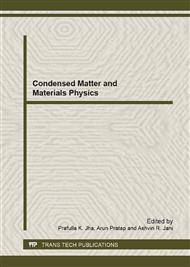p.289
p.297
p.302
p.307
p.311
p.317
p.326
p.330
p.336
Characterization of SnSePb0.1 Thin Films Deposited by Flash Evaporation Technique
Abstract:
Tin Selenide compounds have attracted considerable attention because of their important properties useful for optoelectronics, holographic recording systems, electronic switching and infrared production and detection. Moreover, SnSe is a semiconductor with a band gap of about 1 eV that makes it potential candidate for solar cell material. Further, the optoelectronic properties of SnSe can be modified using doping of lead, copper etc. In this context, we report here results of the preparation and characterization of flash evaporated lead doped SnSe thin films. Thin films of SnSePb0.1 having thickness of 100nm and 500nm were deposited on to chemically cleaned glass substrates. The chemical composition of the deposited SnSePb0.1thin films has been evaluated using EDAX technique. The structure of SnSePb0.1was studied using low angle XRD and it shows that the deposited films are polycrystalline in nature having orthorhombic structure. Various lattice parameters along with micro strain for both 100nm and 500nm thin films have been evaluated. Electrical transport properties have been also investigated using high temperature Hall Effect measurement in the temperature range 300 400K. The decrease in the resistivity of deposited films with increasing temperature confirms the semiconducting behavior of SnSePb0.1 thin films.
Info:
Periodical:
Pages:
311-316
Citation:
Online since:
February 2013
Price:
Сopyright:
© 2013 Trans Tech Publications Ltd. All Rights Reserved
Share:
Citation:


